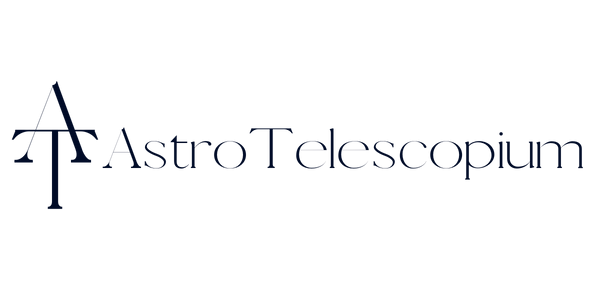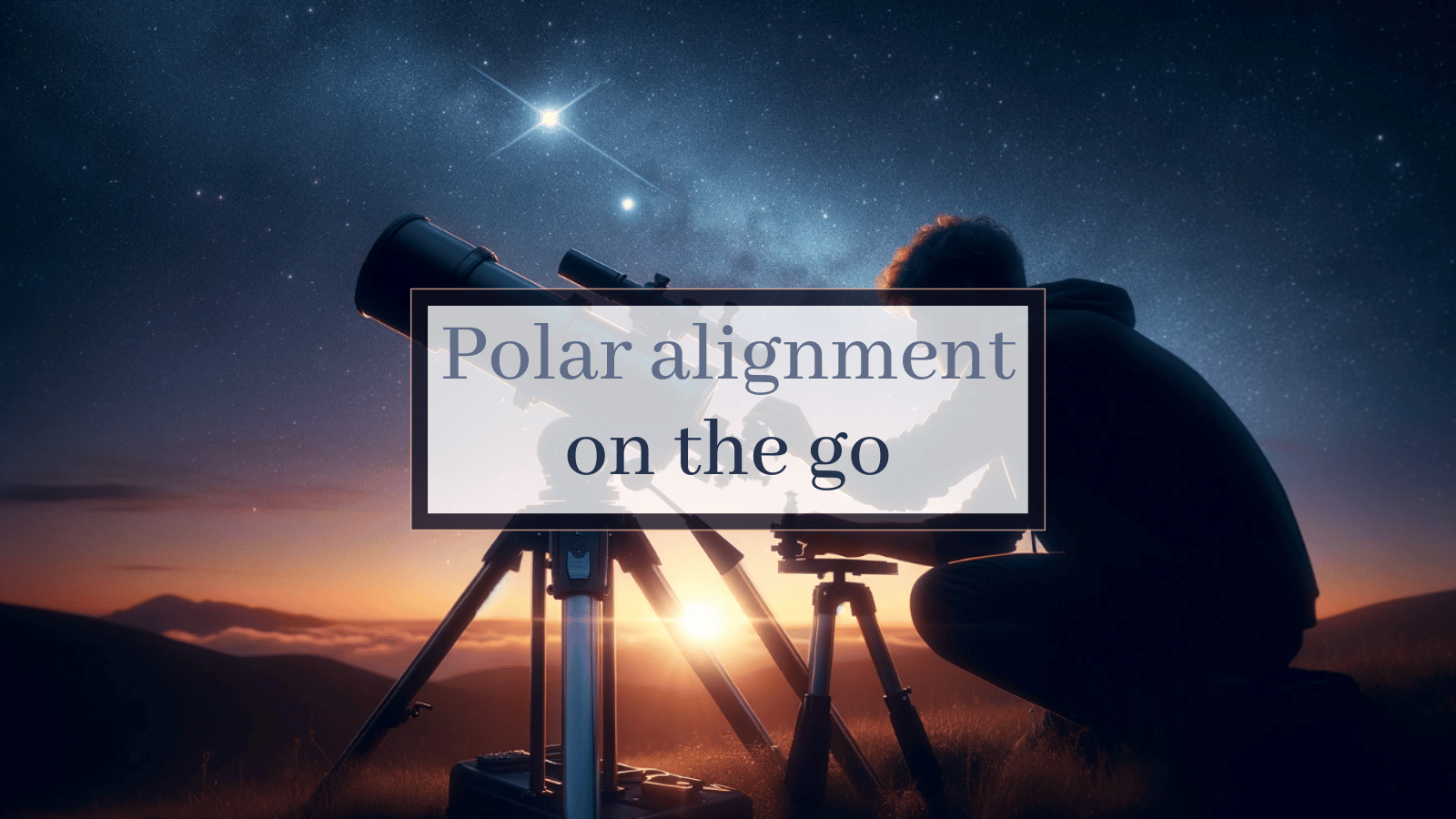Are you passionate about astronomy and exploring the night sky from different locations? Whether you're observing from your backyard, a remote dark sky park, or during your travels, mastering polar alignment is key for the wandering astronomer. It's the gateway to viewing the universe's most breathtaking sights.
The challenge of navigating the night sky changes with each new location—finding true north under different horizons and ensuring your telescope's precise alignment can be daunting.
In this guide, we'll cover the essentials of polar alignment for the mobile astronomer. Our goal is to provide you with the knowledge, strategies, and tips needed for perfect polar alignment, enabling you to explore the cosmos seamlessly, no matter your destination.
Understanding Polar Alignment
Before getting to the heart of polar alignment strategies, it's paramount to understand what polar alignment is and its significance for those who take their telescopes on the road.
Polar alignment is not merely a task—it's an art. It involves adjusting your telescope's mount so that its axis aligns with the Earth's axis of rotation. This precise alignment is a cornerstone for any astronomer aiming to track celestial bodies with accuracy, as it aligns your telescope's movements with the natural rotation of the sky.
The Impact of Polar Alignment on Mobile Astronomy
- Precision in Tracking: Achieving correct polar alignment ensures your telescope can accurately follow the celestial ballet of stars and planets across the night sky. This precision is especially crucial for astrophotography, where long exposures demand flawless tracking to capture the cosmos in all its glory, and for observing celestial phenomena that require you to be on the mark.
- Maximized Viewing Pleasure: When your telescope is perfectly aligned, it drastically reduces the need for manual adjustments. This allows you more time to immerse yourself in the wonders above, making your stargazing sessions more about awe and less about effort.
- Enhanced Portability: For the nomadic astronomer, understanding how to achieve quick and accurate polar alignment transforms setting up in new and unfamiliar locations from a potential chore into a smooth, streamlined process. Knowing the ins and outs of polar alignment empowers you to set up your observatory under any night sky with confidence and ease.
Essential Tips for Streamlining Polar Alignment
Achieving precise polar alignment while on the move can seem daunting, but with the right tools and techniques, it becomes a manageable, even enjoyable part of your astronomical adventures. Here's how to streamline the process:
Embrace Portability in Alignment Tools
Opt for a compact, dependable polar scope or a laser alignment tool designed with mobility in mind. These essential gadgets simplify the task of locating the celestial pole, a boon especially in unfamiliar terrains where every moment counts.
Harness the Power of Astronomy Apps
The digital age offers a constellation of mobile apps tailored for precise polar alignment. Tools such as Polar Scope Align, Stellarium Mobile, and SkySafari not only reveal the current location of Polaris (or the Southern Celestial Pole for those in the southern hemisphere) but also assist in aligning your mount when direct visibility is compromised.
Navigate with a Compass
Incorporate a traditional compass into your toolkit for a quick determination of true north. Given that magnetic and true north may not perfectly align, adjusting for local magnetic declination is crucial. Modern compass apps often include this functionality, marrying ancient navigation with contemporary technology.
Latitude Adjustment Is Key
Geography plays a critical role in polar alignment. The angle of your mount should mirror your current latitude, a specification readily adjusted on portable mounts. Utilize a GPS-enabled device or an app to pinpoint your precise latitude and adjust your equipment accordingly.
Dedication to Practice
The secret to mastering polar alignment, particularly in new and challenging environments, is practice. Experiment with setting up in a variety of conditions and locales to refine your technique. As your proficiency grows, so too will your speed and accuracy in achieving optimal alignment, ensuring each stargazing session is as productive as it is enchanting.
Navigating the Challenges
Even the most seasoned mobile astronomers encounter hurdles that can affect the quality of their stargazing experience. Understanding how to efficiently overcome these common challenges can significantly enhance your observation sessions.
Navigating Through Light Pollution
While escaping to remote wilderness areas is ideal for stargazing, light pollution can still creep into less urbanized locations, diminishing the visibility of celestial bodies. The solution lies in leveraging technology: Light pollution map apps are invaluable tools for identifying the darkest skies near you. By planning your observation sessions around these areas, you can ensure a more pristine viewing environment, letting the cosmos shine in all its glory.
Tackling Varied Terrains
The quest for the perfect stargazing spot often leads to uneven and unpredictable grounds. The key to stability in such conditions is a versatile tripod. Opt for a model that offers adjustability and durability to contend with any surface you might encounter. For added stability, consider using sandbags or weights to anchor your setup, ensuring that your telescope remains steady, allowing for precise alignment and observation.
Managing Time Constraints
The celestial realm operates on its own schedule, often presenting fleeting opportunities for observation. To maximize these brief windows, a deep familiarity with your equipment and the process for rapid polar alignment is essential. Practice setting up and aligning your telescope efficiently to minimize setup time. This readiness ensures that when the universe presents a spectacle, you're prepared to capture the moment, no matter how brief the opportunity may be.
8 Step Polar Alignment Process
Step 1: Initial Setup and Preparation
- Choose Your Location: Find a dark spot with a clear view of the Northern sky, especially where Polaris should be visible.
- Set Up Your Telescope and Mount: Assemble your telescope and attach it to the mount. Ensure the mount is on a stable surface and the tripod legs are securely extended to reduce vibrations.
Step 2: Level the Mount
- Level the Tripod: Before attaching the mount head, use a bubble level to ensure the tripod is level. A level base is critical for accurate alignment.
- Adjust Tripod Legs: Adjust the legs as needed to ensure the bubble is centered in the level. Recheck after any adjustment.
Step 3: Align Mount to True North
- Find True North: Use a compass to find True North. Remember, magnetic north and true north (geographic north) differ. Adjust for your local magnetic declination (the angle difference between true north and magnetic north).
- Adjust Mount Direction: Rotate your mount so that its polar axis (the axis pointing towards Polaris or the celestial pole) is aimed at true north.
Step 4: Set Latitude Angle
- Adjust Mount's Latitude: Each location on Earth corresponds to a latitude angle. Set your mount’s latitude adjustment to match your current location’s latitude. This angle sets the mount's polar axis tilt to parallel Earth's axis.
- Use a Smartphone App: If your mount doesn’t have a latitude scale, use a smartphone app to find your exact latitude and set the mount accordingly.
Step 5: Polar Finderscope Alignment
- Insert the Polar Finderscope: Ensure your mount is equipped with a polar finderscope. Insert it into the designated slot if it’s not already in place.
- Adjust Focus: Look through the finderscope and focus it so that the reticle (the crosshair or circle used for alignment) is sharp.
Step 6: Align with Polaris
- Find Polaris: Look through the finderscope. You may need to adjust the mount's direction slightly to bring Polaris into view.
- Use the Reticle for Precise Alignment: Align Polaris with the specific mark on the finderscope’s reticle that corresponds to its current position in the sky. The exact position of Polaris changes slightly over time due to precession, so consult an app or an astronomical chart for its current position relative to the celestial pole.
Step 7: Fine-Tuning
- Make Minor Adjustments: Use the mount's altitude and azimuth adjustment knobs to make fine adjustments, aligning Polaris precisely with the reticle.
- Check and Recheck: The accuracy of your alignment should be checked periodically throughout your observation or photography session, especially if the mount is moved or bumped.
Step 8: Calibration and Verification
- Calibrate Go-To Systems: If your mount has a Go-To system, follow the manufacturer's instructions to calibrate it post-alignment.
- Verify Alignment: Point your telescope at a known star and track it for several minutes. If it remains in the center of the eyepiece, your polar alignment is accurate. If not, you may need to refine your alignment.
The Journey Forward
Equipped with the right tools, a deep pool of knowledge, and consistent practice, the cosmos opens up to you, providing stargazing adventures that are truly awe-inspiring, regardless of your location.
Mastering mobile polar alignment transforms each venture into the stars into a profoundly enriching experience. You're not merely observing the night sky; you're intimately connecting with it, capturing the splendor of the cosmos with unparalleled accuracy and ease.
So, when you look up, bear in mind: in the realm of astronomy, the only limits that exist are those of your imagination. The universe awaits your discovery.
Copyright © 2024 AstroTelescopium

